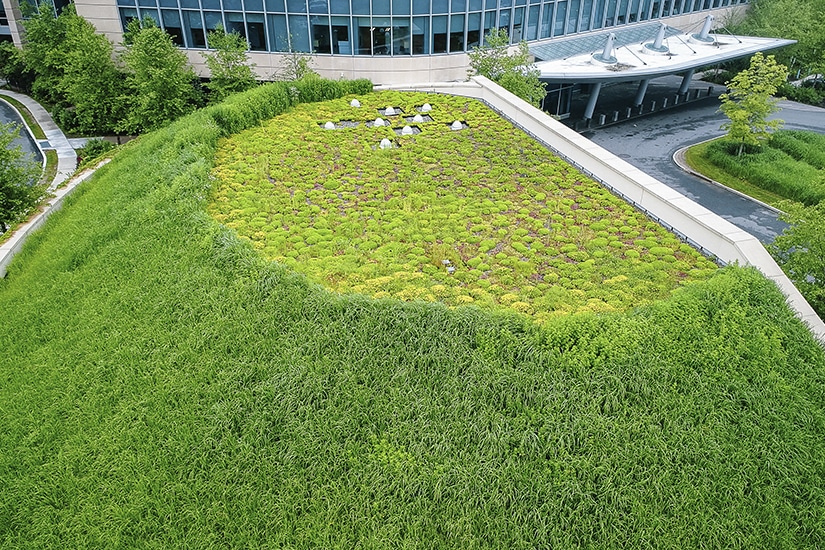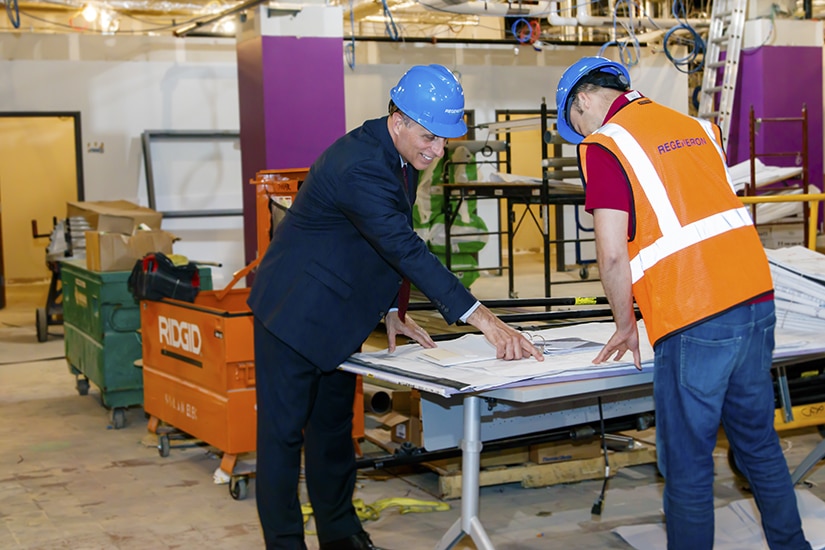|
Getting your Trinity Audio player ready...
|
The last few years have been good for Regeneron, the biotech company known for creating approved medicines and numerous product candidates designed to help people with eye diseases, allergic and inflammatory diseases, cancer, cardiovascular and metabolic diseases, neuromuscular diseases, infectious diseases, and rare diseases. In 2018, the company had $6.7 billion in revenues, with operations in both the US and Europe, it has even won recognition from Science, Forbes, and Fortune magazines for being a great place to work.
If you look a little closer, George Poth is at the center as he manages 1.9 million square feet of the company’s office and research facilities. Look even closer, and you’ll notice that the vice president of real estate and facilities management, tasked with managing a staff of 115 people and five direct reports, must also tend to small things—very, very small things.

It’s Poth’s job to ensure that the environment where the fleet of DNA sequencers are kept is within an exceptionally narrow temperature range at all times. A DNA double helix is approximately 2.5 nanometers wide. (For reference, a sheet of paper is about 100,000 nanometers thick.) It makes sense that Regeneron’s facilities must have a reliable structure and power supply at all times to protect the company’s enormous investment in research.
Poth has been with Regeneron since 2015, having previously managed real estate assets for companies that include AT&T and Daiichi Sankyo for the better part of four decades. With that much experience overseeing a variety of facilities, he notes that one fundamental change affects everything else: building and build-out design are driven by occupant needs and demands. Back in the 1980s and 1990s, buildings were the province and product of the architect and developer.
“There used to be little input from end users in the design,” says Poth. “There wasn’t very much input from employees, either. The real estate industry drove the business, not the other way around.” This dynamic flipped in the late 1990s when companies began to manage costs by inventorying space usage and reducing the square footage per occupant as well as seeking employee input. Builder owners, in turn, were driven to cater to tenant needs.
During roughly the same time period, green building practices followed an accelerated path of innovation and adoption. Poth says that occupational efficiencies, sustainability, and worker health have since become much more the norm in facilities management.

Regeneron reports several gains in these areas. In pharmaceutical research buildings, the temperature, humidity, and backup energy are critically important to ongoing drug development. A newly renovated 75,000-square-foot laboratory building in Tarrytown, New York, was retrofitted with electrochromic insulated glass units (IGUs) that automatically respond to sun intensity (brightness and angle), thus regulating the indoor temperature. This technology reduces glare and the energy needed to cool the building, improving occupant comfort and energy efficiency. A solid oxide fuel cell was also installed, which reduces carbon emissions and provides a dependable source of energy for the building. Additionally, Regeneron produces onsite renewable energy from solar photovoltaic systems at three of its sites. These initiatives have allowed Regeneron to reduce its global electricity intensity (i.e., kWh per full-time employee), even as the company has grown its workforce.
Not Burning Down the House
Every leader has likely had to put out a metaphorical fire or two in their career. But George Poth has put out real flames as a volunteer firefighter in the community where he lived prior to relocating his home to Fairfield County, Connecticut. As a past president of the fire company, he did more than hold a hose. In addition to residential protection, he and fellow firefighters applied their knowledge of structures to plan for fires in the town’s tallest building as well as how to handle conflagrations at a local propane gas enterprise. He says this attention to detail in his private life might be annoying to some (think family vacations), but in matters of life and death, it’s essential.
Regeneron has achieved the LEED Gold certification for two buildings due to exemplary performance in green building. Twenty electric-vehicle charging stations across four sites are available for employees to use free of charge. Color-coded waste systems are utilized to encourage proper disposal of waste items. In addition, Regeneron’s sites incorporate green spaces, native landscaping, and nature trails to promote employee well-being and conserve ecosystems. Together, these initiatives have allowed Regeneron to produce life-transforming medicines while integrating sustainability into all facets of its operations.

“We’re taking a similar approach with a 383,000-square-foot administrative office building,” says Poth. The three-story structure will install the same electrochromic insulated glass units, but he adds how it wasn’t an automatic change based on the first building’s success. This means each was independently evaluated for HVAC systems, heat loads, building orientation, and other control systems. Poth credits “talented engineers on staff who test and evaluate all factors.”
Poth acknowledges these modern changes weren’t always so smartly considered in advance. With a previous employer in the mid-1990s, the nature and configuration of office layouts were changed in a single stroke—and fatally for the program, they were designed in a vacuum.

“We had about 700,000 square feet of building composed of 600 private offices that were changed to smaller spaces in an open landscape,” he says. “There was no evolution to this, it was poorly communicated, and with no employee input.” After spending tens of millions on the reconfiguration, the company found that employee health metrics took a downward turn. Within 18 months, it all began to revert to something similar to the previous spaces.
Some things have to be learned over time. As Poth now advocates, gathering employee input can lead to a hybrid of solutions. The company has a fully modern mix of collaborative and private spaces—Poth himself doesn’t have a door on his own office—that include phone booth and meeting pods as well as sit-stand desks. Many interior glass walls throughout the space are designed to admit natural lighting into the space.
“This is based on our culture,” he says, which is clearly no small thing.
LeChase: For over 75 years, our drive to be the premier provider of construction services has inspired us to aim for perfection in everything we do. Our team of skilled professionals has earned a reputation for integrity, quality, and safety—and for building partnerships across the Tri-State area. Learn more: www.lechase.com.


